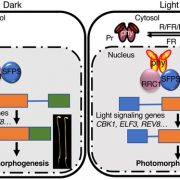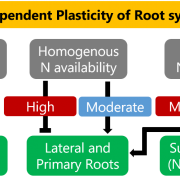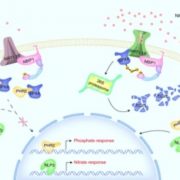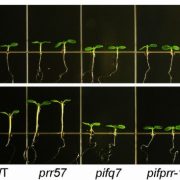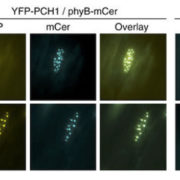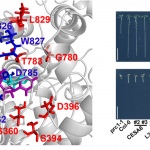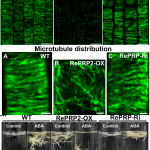MYB30 negatively regulates photomorphogenesis by interacting with PIFs and phytochromes in Arabidopsis (Plant Cell)
 Photomorphogenesis is the growth and development of plants in response to light. The phytochrome family of photoreceptors absorbs red and far-red light, and in Arabidopsis the most abundant phytochromes are phyA and phyB. PHYTOCHROME-INTERACTING FACTORS (PIFs) repress photomorphogenesis, and under red light, phytochromes mediate PIF degradation. Here, Yan et al. reveal MYB30 as a negative regulator of photomorphogenesis. Under darkness, PIF4 and PIF5 encourage hypocotyl elongation by instigating the expression of growth-promoting genes, while MYB30 protein levels are kept low due to proteasome-mediated degradation. During short exposure to red light, active phyA and phyB facilitate PIF4 and PIF5 proteasome-mediated degradation and induce MYB30 abundance. Under longer exposure to red light, MYB30 directly binds to PIF4 and PIF5 promoters, inducing their reaccumulation while simultaneously inhibiting PIF-phytochrome interactions. Finally, MYB30 interacts with PIFs to collectively repress photomorphogenesis by inducing the expression of growth-promoting genes. In summary, MYB30 is an essential regulator of PIF-phytochrome signaling and facilitates the efficient and accurate response of plants to dynamic light conditions. (Summary by Caroline Dowling @CarolineD0wling) Plant Cell 10.1105/tpc.19.00645
Photomorphogenesis is the growth and development of plants in response to light. The phytochrome family of photoreceptors absorbs red and far-red light, and in Arabidopsis the most abundant phytochromes are phyA and phyB. PHYTOCHROME-INTERACTING FACTORS (PIFs) repress photomorphogenesis, and under red light, phytochromes mediate PIF degradation. Here, Yan et al. reveal MYB30 as a negative regulator of photomorphogenesis. Under darkness, PIF4 and PIF5 encourage hypocotyl elongation by instigating the expression of growth-promoting genes, while MYB30 protein levels are kept low due to proteasome-mediated degradation. During short exposure to red light, active phyA and phyB facilitate PIF4 and PIF5 proteasome-mediated degradation and induce MYB30 abundance. Under longer exposure to red light, MYB30 directly binds to PIF4 and PIF5 promoters, inducing their reaccumulation while simultaneously inhibiting PIF-phytochrome interactions. Finally, MYB30 interacts with PIFs to collectively repress photomorphogenesis by inducing the expression of growth-promoting genes. In summary, MYB30 is an essential regulator of PIF-phytochrome signaling and facilitates the efficient and accurate response of plants to dynamic light conditions. (Summary by Caroline Dowling @CarolineD0wling) Plant Cell 10.1105/tpc.19.00645


